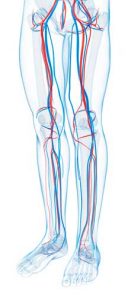What is it Chronic Venous Insufficiency?
Chronic venous insufficiency (CVI) is a common cause of leg pain and swelling and is commonly associated with varicose veins. It occurs when the valves of the veins do not function properly, and the circulation of blood in the leg veins is impaired. CVI may affect up to 20 percent of adults. CVI can be caused by damaged valves in the veins or vein blockage. Both may be a result of deep vein thrombosis (DVT) or blood clots in the deep veins of the legs. If a clot forms in the superficial veins, there is a very low risk of DVT occurring.
Age and Chronic Venous Insufficiency
Over time, CVI may result in varicose veins, swelling and discoloration of the legs, itching, and the development of ulcers near the ankles. Vein problems are among the most common chronic conditions in North America. In fact, more people lose work time from vein disorders than from artery disease. By the age of 50, nearly 40 percent of women and 20 percent of men have significant leg vein problems. Spider veins occur much more frequently in women. It is estimated that at least 20 to 25 million Americans have varicose veins.
Understanding Chronic Venous Insufficiency
Problems with the veins in the legs may lead to chronic venous insufficiency (CVI). Chronic Venous Insufficiency is a condition that develops over several years, due to faulty valves in the veins. Early symptoms include ankle and leg swelling. If not treated, capillaries in the tissue surrounding diseased veins may burst, causing reddish-brown skin discoloration. In addition, non-healing sores called venous stasis ulcerations may appear.
Problems that may lead to chronic venous insufficiency are:
- Damaged valves. Valves keep blood flowing from the legs through the blood vessels and back to the heart. When the valves are damaged, blood does not flow as well.
- Deep vein thrombosis (DVT). Blood clots may form in the deep veins of the legs. This may cause pain, redness, and swelling in the legs. It may also block the flow of blood back to the heart. Seek medical care right away if you have these symptoms.
- A blood clot in the leg can also break off and travel to the lungs. This is called pulmonary embolism (PE). In the lungs, the clot can cut off the flow of blood. This may cause chest pain, trouble breathing, sweating, a fast heartbeat, coughing (may cough up blood), and fainting. It is a medical emergency and may cause death. Call 911 if you have these symptoms.
Healthcare providers call the two conditions, DVT and PE, venous thromboembolism (VTE).
CVI can’t be cured, but you can control leg swelling to reduce the likelihood of ulcers (sores).
Recognizing the Symptoms
Be aware of the following:
- If you stand or sit with your feet down for long periods, your legs may ache or feel heavy.
- Swollen ankles are possibly the most common symptom of CVI.
- As swelling increases, the skin over your ankles may show red spots or a brownish tinge. The skin may feel leathery or scaly and may start to itch.
- If swelling is not controlled, an ulcer (open wound) may form.
While in many cases the venous disease may be seen on the skin surface, however, in many cases oftentimes they are not. Once again, even if you do not visually see varicose or spider veins on the surface of the skin, it is not indicative of what is happening underneath the surface. Therefore, symptoms often associated with venous disease include leg pain, heaviness, throbbing, swelling, itching, restlessness, fatigue, numbness, cramping, and burning.
Diagnosis and Treatment
Large varicose veins may indicate a critical blockage in deeper veins, a condition called deep vein thrombosis, that can be life-threatening. At Shinsegae Heart & Vascular Center, our technologists are trained to do a special ultrasound test called a venous insufficiency duplex to determine if the valves in the veins are functioning properly and to check for evidence of a blood clot. Based on the test findings, a treatment plan will be recommended by our physician to best treat this disease. There are several minimally invasive outpatient treatment options with a high success rate of treating chronic venous insufficiency.
If you or a loved one shows any symptoms of CVI, we encourage you to make an appointment with one of our specialists. Please contact us at 904.339.2335.
